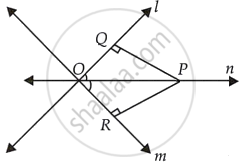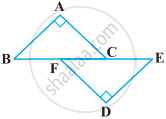Advertisements
Advertisements
प्रश्न
Two lines l and m intersect at the point O and P is a point on a line n passing through the point O such that P is equidistant from l and m. Prove that n is the bisector of the angle formed by l and m.
उत्तर
Given: Two lines l and m intersect at the point O and P is a point on a line n passing through O such that P is equidistant from l and m i.e., PQ = PR.

To prove: n is the bisector of the angle formed by l and m i.e., n is the bisector of ∠QOR.
Proof: In ΔOQP and ΔORP,
∠PQO = ∠PRO = 90° ...[Since, P in equidistant from l and m, so PQ and PR should be perpendicular to lines l and m respectively]
OP = OP ...[Common side]
PQ = PR ...[Given]
∴ ΔOQP ≅ ΔORP ...[By RHS congruence rule]
⇒ ∠POQ = ∠POR ...[By CPCT]
Hence, n is the bisector of ∠QOR.
Hence proved.
APPEARS IN
संबंधित प्रश्न
ABC is a right angled triangle in which ∠A = 90° and AB = AC. Find ∠B and ∠C.
AD is an altitude of an isosceles triangles ABC in which AB = AC. Show that
- AD bisects BC
- AD bisects ∠A
In two right triangles one side an acute angle of one are equal to the corresponding side and angle of the other. Prove that the triangles are congruent.
Prove that in a quadrilateral the sum of all the sides is greater than the sum of its diagonals.
In the following figure, BA ⊥ AC, DE ⊥ DF such that BA = DE and BF = EC. Show that ∆ABC ≅ ∆DEF.

ABC is an isosceles triangle in which AC = BC. AD and BE are respectively two altitudes to sides BC and AC. Prove that AE = BD.
Prove that sum of any two sides of a triangle is greater than twice the median with respect to the third side.
ABCD is a quadrilateral such that diagonal AC bisects the angles A and C. Prove that AB = AD and CB = CD.
ABC is a right triangle such that AB = AC and bisector of angle C intersects the side AB at D. Prove that AC + AD = BC.
ABCD is quadrilateral such that AB = AD and CB = CD. Prove that AC is the perpendicular bisector of BD.
